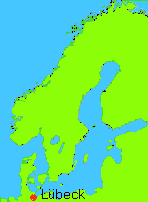Meet the Middle Ages
BackLybeck

Lübeck was founded in the 1140 ´s. The town was moved to its present-day location by Henry the Lion in 1159. South of Lübeck lay the most important salt-mine in northern Europe. Because of the salt, Lübeck became an especially important commercial centre. Salt was vital to people in northern Europe, who needed it to preserve their food. The herring, meat and butter, which was exported from the Nordic countries, was also salted. In this way, it did not go bad during long transports.
In 1216, Lübeck was released from the county of Holstein and became a free town, ruled only by the Emperor of the German-Roman Empire. Lübeck became a centre for the trade on the Baltic Sea. When the towns joined together in a trading company, the Hanseatic League, Lübeck was the leading town.
Merchandise from the entire Baltic region was shipped to Lübeck: iron, herring, meat, flax, and fur. Red wine from France, woollen cloth from Flanders, spices, silks and expensive colour pigments from Venice and Genoa was retailed to northern Europe. Lübeck was vital to the Baltic trade. Goods arrived from all countries and sold on.
During the Middle Ages merchants and the clergy competed for power in Lübeck. In the 14th century, the struggle came to an end as the merchants seized power. As a sign of their great influence, they had a huge Town Hall built, which is still standing. Beside the Town Hall, at the highest point of the town, they built their own church, St. Mary’s. It rose higher than the cathedral. It was obvious to everyone that the merchants ruled the town.
Lübeck was severely damaged during English bomb-raids in 1942, but some of the medieval buildings have been restored.